Publishing Under Fire: The Nippon Fijii and the Aftermath of Pearl Harbor…
December 8, 2025 by GuyHeilenman · Leave a Comment
It’s difficult to fathom what it must have been like to be a Japanese-American living in Hawaii at the time of the Pearl Harbor attack. According to the 1940 census, more than 150,000 Japanese-Americans—roughly 35% of Hawaii’s population—suddenly found themselves in an impossible position, caught between loyalty to their home and suspicion from their neighbors.
Fear quickly swept through the islands. While the sheer size of the Japanese-American community made mass internment in Hawaii unfeasible, more than 2,000 individuals were arrested, many later sent to internment camps on the mainland. Their lives—and their trust in the nation they called home—were forever changed.
It was in the midst of this uncertainty and fear that the staff of NIPPON FIJI, Hawaii’s leading Japanese-language newspaper, produced their December 8, 1941 issue. The paper stands today as one of the most striking and rare firsthand publications from that dark and defining moment in American history.
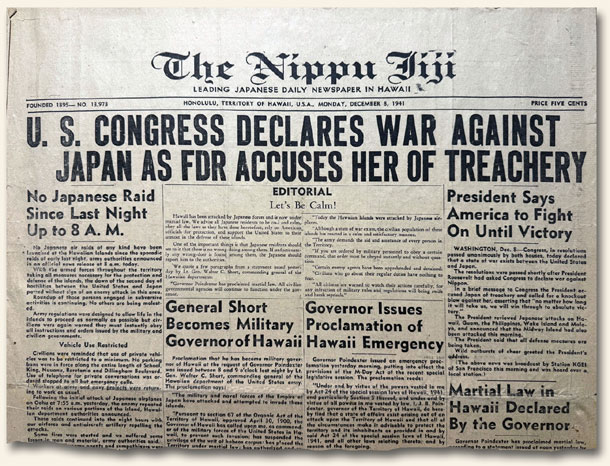
Announcing: Catalog #361 for December, 2025 – Rare & Early Newspapers…
December 1, 2025 by GuyHeilenman · Leave a Comment
|
|
From the Vault: The top ten: “20th century”…
November 21, 2025 by TimHughes · 9 Comments
From this period in newspaper publishing history, displayability has much to do with the desirability of a newspaper, perhaps more so than historical significance. Since I come to this task of listing the “top ten” from the perspective of a rare newspaper dealer and knowing the requests we receive for certain events, the following list may not be the same as my most “historic” but they are my thoughts for the most “desirable” based on customer demand. Certainly FDR’s New Deal is more historically significant than the death of Bonnie & Clyde, but not more desirable from a collector standpoint. I’d be curious to hear of your thoughts.
 Here they are, beginning with number ten:
Here they are, beginning with number ten:
10) St. Valentine’s Day Massacre, Feb. 14, 1929 An issue with a dramatic banner headline, & ideally dated the 14th. Morning papers would be dated the 15th.
9) Death of Bonnie & Clyde, May 23, 1934 The gangster era remains much in demand, & perhaps due to the movie this event beats out Dillinger, Capone & the others from the era. A dramatic headline drives desirability–ideally with a photo–even if not in a Louisiana newspaper.
8.) Charles Lindbergh flies the Atlantic, May 22, 1927 The New York Times had a nice headline account with a map of the route, and the prestige of the newspaper always keeps it in high demand.
 7) Call-Chronicle-Examiner, San Francisco, April 19, 1906 I note a specific title & date for this event, as these 3 newspapers combined to produce one 4 page newspaper filled with banner heads & the latest news. No advertisements.
7) Call-Chronicle-Examiner, San Francisco, April 19, 1906 I note a specific title & date for this event, as these 3 newspapers combined to produce one 4 page newspaper filled with banner heads & the latest news. No advertisements.
6) Crash of the Hindenberg, May 6, 1937 The more dramatic the headline the better, & ideally with the Pulitizer Prize winning photo of the airship in flames.
5) Wright brothers fly, Dec. 17, 1903 Here’s where the significance of the event drives desirability over dramatic appeal. Few can argue the impact of manned flight on the world. Reports were typically brief & buried on an inside page with a small headline, so a lengthy front page report would be in top demand.
4) Stock market crash, October, 1929 Demand is driven by the dramatic headline and its wording. Too many newspapers tried to put an optimistic spin on the tragedy. Collectors want “collapse, disaster, crash” & similarly tragic words in the headline (how about Variety magazine’s: “Wall Street Lays On Egg”?)
 3) Honolulu Star-Bulletin, Dec. 7, 1941 “1st Extra” The defining issue from World War II but be careful of reprints as most issues on the market are not genuine.
3) Honolulu Star-Bulletin, Dec. 7, 1941 “1st Extra” The defining issue from World War II but be careful of reprints as most issues on the market are not genuine.
2) Chicago Daily Tribune, Nov. 3, 1948 “Dewey Defeats Truman”. What more need be said?
1) Titanic sinking, April 14, 1912 Certainly low on the historically significant list, but off the charts on the desirability scale, much due to the block-busting movie. The more dramatic the headline the better, and hopefully with a nice illustration of the ship going down.
My “honorable mention” list might include baseball’s “Black Sox” scandal of 1919, sinking of the Lusitania, end of World War II, D-Day, JFK’s election, the New Deal, a great Babe Ruth issue, etc. Maybe they would rank higher on your list. Feel free to share your top choices.
Great Headlines Speak for Themselves… The First Moon Walk…
November 17, 2025 by GuyHeilenman · Leave a Comment
The best headlines need no commentary. Such is the case with the WAPAKONETA DAILY NEWS, Ohio, July 21, 1969, which reported the first moon walk. Whereas most newspapers declared some variation of: “Man Walks on the Moon”, this one was a little more specific – perhaps because it was his hometown newspaper:
“NEIL STEPS ON THE MOON”
Who’s Who in Newspapers – John Wanamaker edition
November 10, 2025 by GuyHeilenman · 1 Comment
Typically, our “Who’s Who in Newspapers” series highlights individuals who were unfamiliar to me before I delved into the world of Rare & Early Newspapers. Today’s post is a departure from that norm. While reviewing the December 12, 1922, issue of The Bethlehem Times, I came across a front-page report of John Wanamaker’s passing. The article stirred a flood of childhood memories tied to this remarkable man whose legacy left a lasting impression on me. Eager to share his story, I hope the following introduction sheds light on his extraordinary contributions.
John Wanamaker: The Merchant Who Made Shopping an Experience
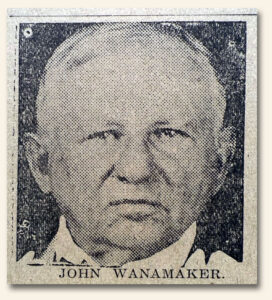 From personal memories to retail innovation, Wanamaker’s left a legacy that reshaped both commerce and tradition. Every December starting in the mid-1950s, my parents bundled up my siblings and me for a trip into Philadelphia to see the Christmas light and music show at Wanamaker’s (currently being converted into a mixed-use facility). To us, it was pure magic — thousands of twinkling lights, the sound of the great pipe organ, and crowds of families gathered in awe. With my grandmother working in the store during those years, Wanamaker’s always felt like more than a department store — it felt like part of our family’s story.
From personal memories to retail innovation, Wanamaker’s left a legacy that reshaped both commerce and tradition. Every December starting in the mid-1950s, my parents bundled up my siblings and me for a trip into Philadelphia to see the Christmas light and music show at Wanamaker’s (currently being converted into a mixed-use facility). To us, it was pure magic — thousands of twinkling lights, the sound of the great pipe organ, and crowds of families gathered in awe. With my grandmother working in the store during those years, Wanamaker’s always felt like more than a department store — it felt like part of our family’s story.
That sense of wonder was no accident. John Wanamaker (1838–1922), the man behind the store, believed shopping could be more than a transaction — it could be an experience. When he opened his Philadelphia department store in 1876, it quickly became a model for modern retail. Wanamaker pioneered the one-price system (no haggling), introduced the money-back guarantee, and used newspaper advertising on a scale few had seen before.
He also reshaped how Americans paid for what they bought. Realizing that many working families couldn’t afford to pay cash for larger purchases, Wanamaker offered installment plans and charge accounts. This bold move laid the foundation for consumer credit, opening the door for more households to access quality goods.
Beyond retail, Wanamaker served as U.S. Postmaster General under President Benjamin Harrison, introducing commemorative stamps and expanding rural mail delivery. Yet it was his Philadelphia store — both marketplace and civic landmark — that became his greatest legacy.
Even today, the memory of standing with my siblings beneath the glow of the light show while the Wanamaker organ thundered through the Grand Court remains a vivid reminder of how one man’s vision reshaped not just shopping, but tradition itself.
Wanamaker’s Firsts – Innovations that reshaped retail
- One-Price System – Ended the practice of haggling; everyone paid the same fair price.
- Money-Back Guarantee – Built customer trust and loyalty.
- Large-Scale Advertising – One of the first to use newspapers to reach wide audiences.
- Department Store Experience – Turned shopping into a cultural outing with art, music, and public events.
- Consumer Credit – Introduced installment plans and charge accounts, paving the way for modern credit.
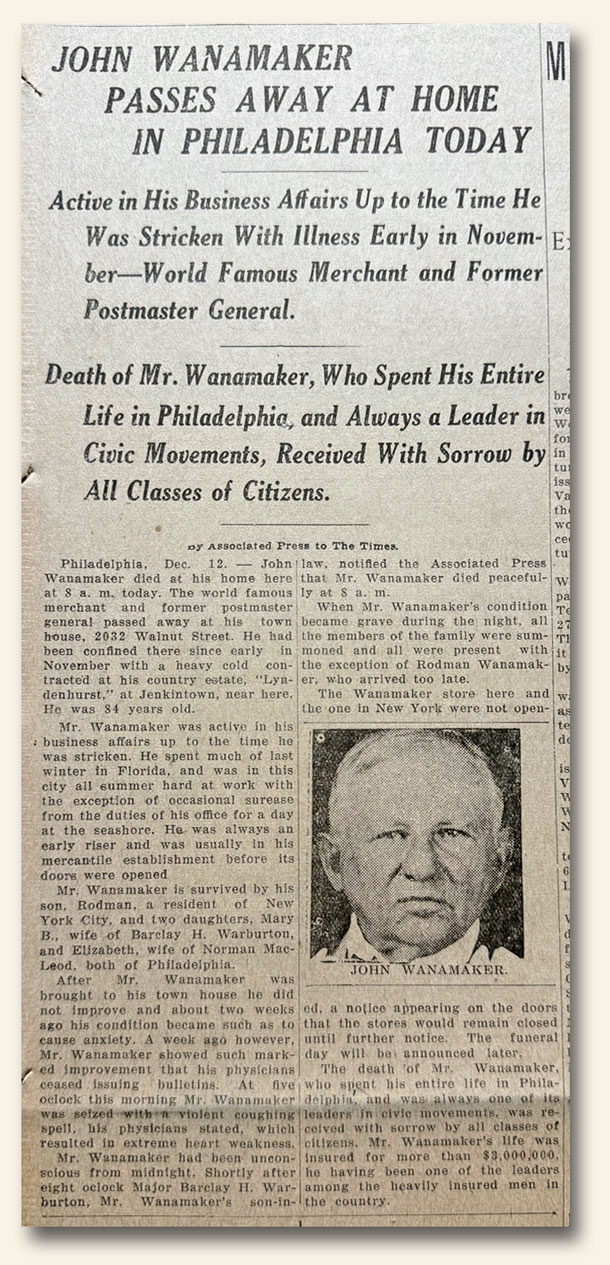
The reason I collected it: the Nuremberg trials…
November 3, 2025 by TimHughes · Leave a Comment
I have likely stated several times that part of the quest in seeking the best report of a notable event is to find it in a newspaper as close to where it happened as possible. For the death of JFK, a Dallas newspaper is best. On the bombing of Pearl Harbor, a Honolulu newspaper is great. On the Boston Massacre in 1770, a Boston paper would be wonderful.
Some events can be extremely difficult, so you do the best you can. How about when man walked on the moon? Outside of a lunar publication that did not exist, a newspaper from Neil Armstrong’s hometown is pretty good. Or perhaps one from close to Cape Canaveral.
One of the more notable events at the conclusion of World War II was the Nuremberg Trials. There were 22 defendants held for war crimes; 12 would hang, 7 served time, and 3 found not guilty.
But finding a German newspaper with this report had eluded us. And as is the case with events in foreign language countries, a report close to the event would be diminished a bit if the text is in a language other than English. Not many desire a newspaper they cannot read.
But as luck would have it, a Nuremberg suburb–Furth–had a former Nazi air base, captured by American forces in early April, 1945 & converted to a U.S. air base. And better yet, it produced a small, obviously low-circulation newspaper called “The Jet Gazette”. The October 1, 1946 issue was devoted to the results of the trials. And being an American air base, it’s in English. It was a great find that I suspected never existed!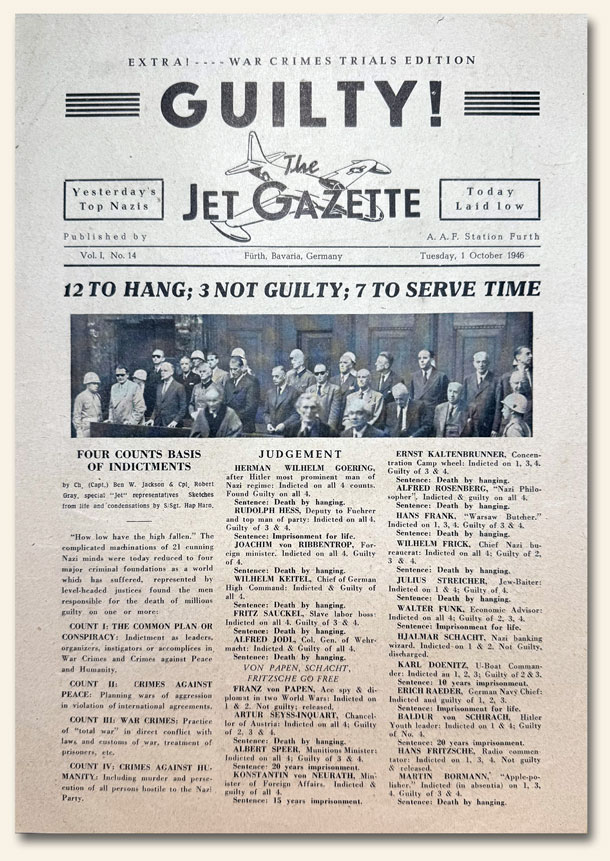
Announcing: Catalog #360 for November, 2025 – Rare & Early Newspapers…
October 31, 2025 by GuyHeilenman · Leave a Comment
|
|
From the Vault: Headlines drive interest in World War II…
October 24, 2025 by TimHughes · Leave a Comment
For likely a multitude of reasons, interest in World War II newspapers ranks far higher than in the Korean War, World War I, or the Spanish-American War. It may be a generational thing, as most collectors today are children of World War II veterans and likely heard stories of the war first-hand, or found  newspapers in their parents attics which sparked an interest. One could debate a number of other possible reasons why other wars lack the intrigue found in that fought by the “greatest generation”.
newspapers in their parents attics which sparked an interest. One could debate a number of other possible reasons why other wars lack the intrigue found in that fought by the “greatest generation”.
Headline collecting has always been a focus for this hobby, and as any collector knows, bold, banner headlines did not become commonplace until late in the 19th century. With the increasing competitiveness of daily newspapers across the country–Hearst, Pulitzer & others rising to prominence–flashier front pages were needed to draw attention at the corner news stand. It’s a shame there is not more interest in the Spanish-American War and World War I as both events resulted in some huge, dramatic, & very displayable headlines.
Because there are a plethora of newspapers from the WWII era available, collectors have become very discriminating in what they collect. Only the “best of the best” will do, meaning just the major events and only those with huge and displayable headlines. If there is a “top 6” list of sought-after events, our experience is they would be: 1) attack on Pearl Harbor; 2) the D-Day invasion; 3) death of Hitler; 4) end of the war in Europe; 5) dropping of the atomic bomb; 6) end of the war in the Pacific. One could add any number of other battle reports such as Midway, battle of the Bulge, fall of Italy, Iwo Jima, battle for Berlin, and so much more. And we could step back before American involvement in the war and add Hitler’s invasion of Poland and the battle of Britain.
The bigger the headline the better. With some newspapers the entire front page was taken up with a headline and a related graphic. The U.S. flag was a common patriotic device. Tabloid-size newspapers commonly had the front page entirely taken up with a singular headline and tend to be better for display given their smaller size.
 And not just American newspapers draw interest. German newspapers hold a special intrigue, but the language barrier is a problem for many. But the British Channel Islands, located in the English Channel between England & France, were occupied by the Nazi during the war so their reports were very pro-Nazi while printed in the English language (ex., Guernsey Island). And the military newspaper “Stars and Stripes“, while certainly being American, was published at various locations in Europe and the Pacific. Collectors have a special interest in finding World War II events in the official newspapers of the American military forces. Plus there were a multitude of “camp” newspapers, amateur-looking newspapers printed on a mimeograph machine for consumption limited to a military base, and typically printed is very small quantities. Their rarity is not truly appreciated by many.
And not just American newspapers draw interest. German newspapers hold a special intrigue, but the language barrier is a problem for many. But the British Channel Islands, located in the English Channel between England & France, were occupied by the Nazi during the war so their reports were very pro-Nazi while printed in the English language (ex., Guernsey Island). And the military newspaper “Stars and Stripes“, while certainly being American, was published at various locations in Europe and the Pacific. Collectors have a special interest in finding World War II events in the official newspapers of the American military forces. Plus there were a multitude of “camp” newspapers, amateur-looking newspapers printed on a mimeograph machine for consumption limited to a military base, and typically printed is very small quantities. Their rarity is not truly appreciated by many.
For obvious reasons, there is also a high degree of collectible interest from those wishing to make sure certain aspects of history are not forgotten. The Holocaust, and the Nazi propaganda used to provide a rationale for eliminating the Jewish people, is well documented in newspapers from the era. In addition to the Holocaust and its atrocities, issues providing context through reporting other pre-war events such as the Great Depression, fascism, and increased militarism, are also desirable.
True to any collectable field, newspaper collectors are always on the lookout for an issue better than what they have, and collection upgrades are constant. Finding that special, rare, unusual or fascinating headline is what makes the hobby fun. Will interest in the Korean War and the Vietnam War gain more interest in future years? Perhaps so. With interest currently low and availability and prices very attractive, it might be a good time to explore.
Headlines That Never Happened: Germany’s Loss and Its Lasting Echoes…
October 20, 2025 by GuyHeilenman · Leave a Comment
In April of 1918, a newspaper playfully speculated on what the headlines might have looked like if Germany had won World War I. A century later, we know the opposite outcome set in motion consequences far greater than most could have imagined. Germany’s defeat, and the way the Allies handled it, reshaped not just Europe but the modern world.
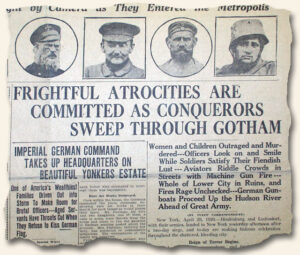 The Ripple Effects of Germany’s World War I Defeat
The Ripple Effects of Germany’s World War I Defeat
The Treaty of Versailles (1919) imposed heavy reparations, territorial losses, and strict military limits on Germany. Instead of securing peace, these terms humiliated the nation and destabilized its young democracy. The resentment they bred became fertile ground for Adolf Hitler and the Nazi Party, leading to World War II and the Holocaust.
Europe’s New Order
Britain and France emerged victorious but weakened, while the United States stepped into global leadership. Versailles became a cautionary tale: punish a nation too harshly, and you may guarantee the next war. After World War II, the Allies took the opposite approach—rebuilding Germany through the Marshall Plan and anchoring it in NATO and the European Union. Today, Germany’s central role in both reflects that strategy.
Jews and the Holocaust
Germany’s turmoil fueled dangerous scapegoating. Conspiracy theories like the “stab-in-the-back” myth cast Jews as traitors, intensifying antisemitism that Nazi propaganda later weaponized. The Holocaust destroyed European Jewry and gave new urgency to the Zionist movement, leading to the founding of Israel in 1948.
Redrawing the Middle East
The collapse of Germany’s ally, the Ottoman Empire, allowed Britain and France to carve up the Middle East. Mandates in Iraq, Syria, and Palestine ignored ethnic and religious realities. Britain’s contradictory promises to Jews and Arabs in Palestine set the stage for the enduring Israeli-Palestinian conflict.
Lasting Echoes
The “war to end all wars” did not end conflict—it reshaped it. From NATO and the EU to Israel’s creation and Middle Eastern instability, the ripple effects of Germany’s defeat still define our world.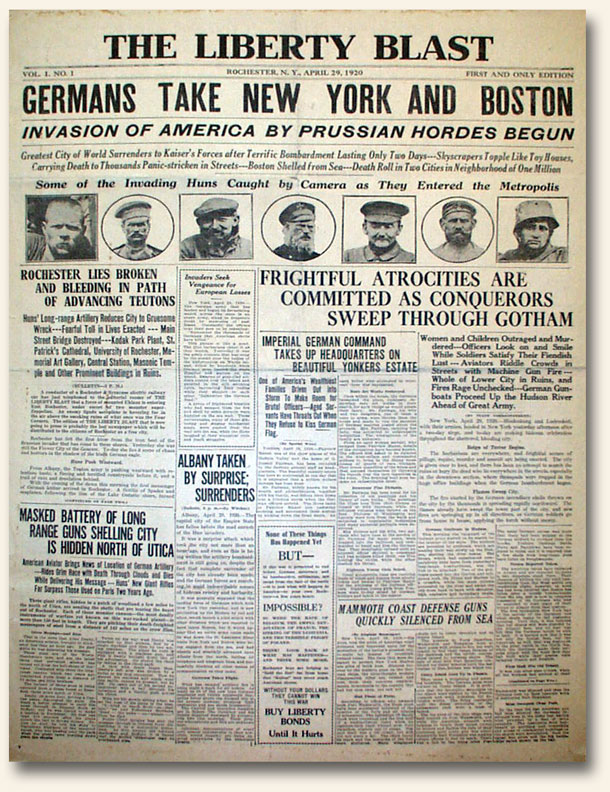
While the two photos above show The Liberty Blast with a dateline of April 29, 1920, this newspaper with “fictious reporting” was actually printed on April 20, 1918 “in the hope that in some small way it may serve to awaken in the hearts & minds of those who read it a realization of those horrors of a great world war, so far from and yet to near to American shores, American life, and American people…”.
What if Germany won World War I ?
October 6, 2025 by TimHughes · Leave a Comment
Some of the more intriguing newspapers are “futuristic” editions, those printed with a dateline 50 or 75 years in the future, filled with reports of what editors presumed life would be like at that time. They always prove to be very interesting reading.
We recently came upon a “what if” newspaper. Although we’ve had a few, including use of the atomic bomb on American cities, or end-of-the-world scenarios, this issue of “The Liberty Blast” (shown below) is printed as if Germany had won World War I. Although the dateline reads “April 29, 1920”, the editorial on page 2 notes that it was published on April 29, 1918, before World War I had come to an end.
The reporting is fascinating. See the many photos for what the editors thought could have happened. The page 2 editorial in this edition–the first any only of this title–was meant to: “…awaken in the hearts and minds of those who read it a realization of those horrors of a great world war…near to American shores…”.
An interesting issue to read. One of the many treasures to be discovered in the pursuit of this fascinating hobby!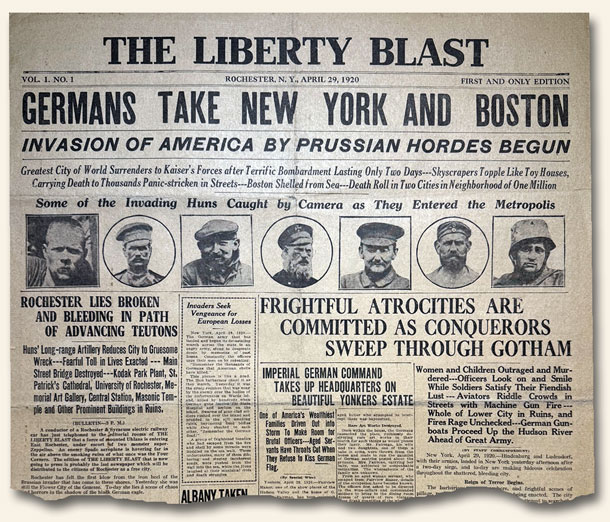
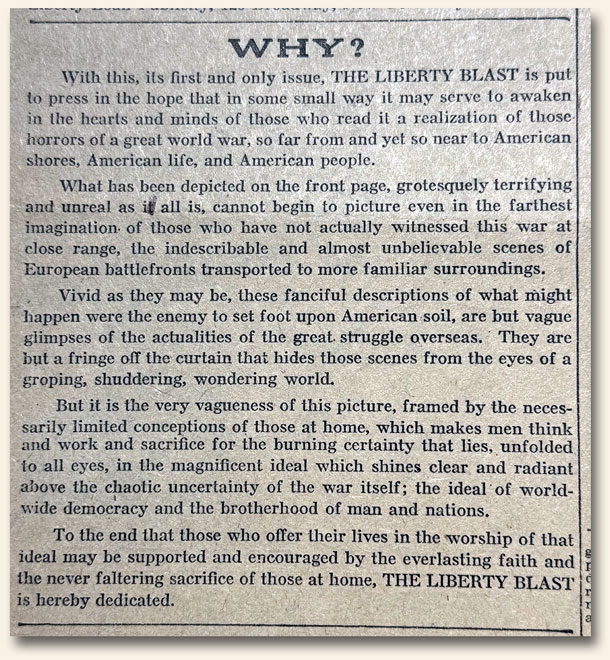





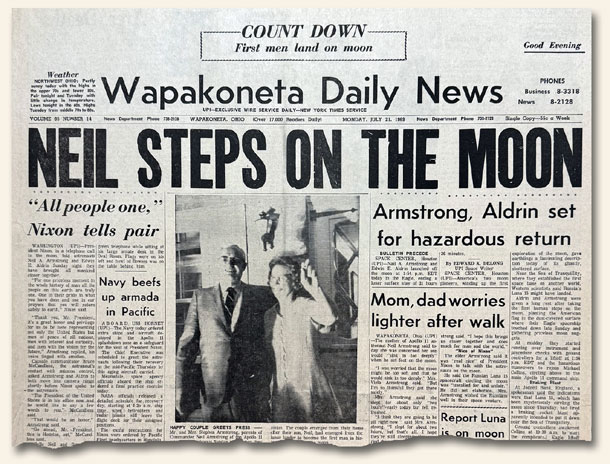
 Catalog #360 (for November)
Catalog #360 (for November)